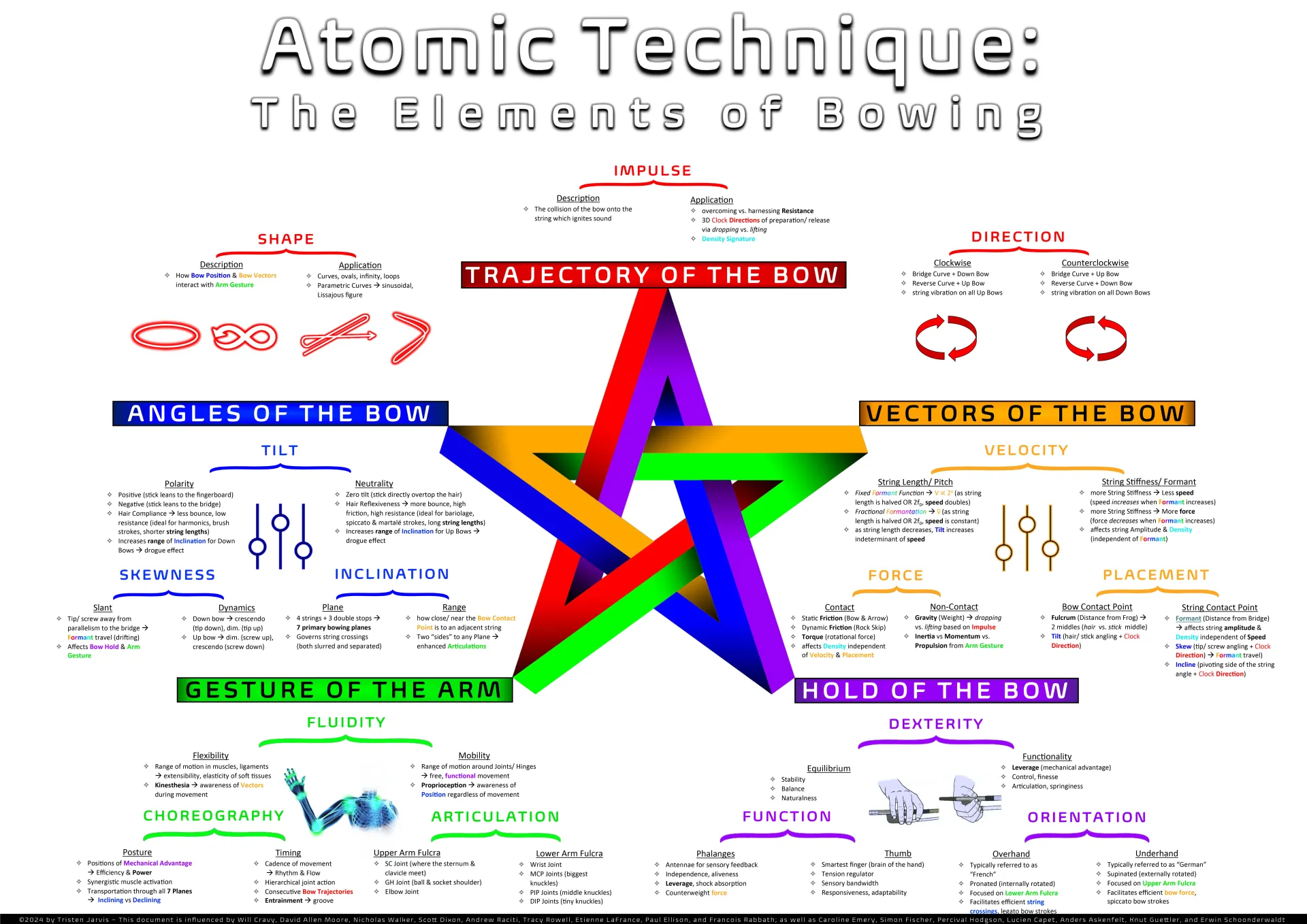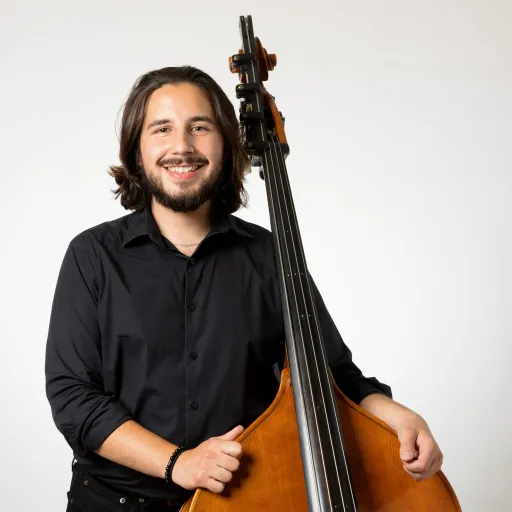Atomic Technique: The Elements of Bowing

About "Atomic Technique"
Part of my obsession as a string player is understanding as much as I possibly can about how to use the bow. The document above is a "living" project I've been working on since 2020 that I call Atomic Technique. It is my best attempt to convey how the intricate process of bowing a string exists inside my brain in a method similar to how single atoms can be broken down into sub-atomic particles (or, combined with other atoms to make molecules). At the moment, I believe there are 15 isolatable Bowing Elements to be broken down from 5 overall Facets, or “Families,” that are absolutely integral to virtuosic bow technique.
I'm constantly updating the document as I continue to learn and explore more about string playing from my own teachers, mentors, and musicians that I admire from afar. Here at Ithaca College I’ve designed a right-hand curriculum for my double bassists in which they are able to individually practice any of these 15 Elements through use of interval timer apps (an idea taught to me by my mentor and predecessor, Nicholas Walker). This practice takes advantage of the latest science on skill acquisition via a process called Interleaving Practice. Combining the conceptual/ logistical understanding of the 15 bowing parameters with the visual/tactile Interleaving Practice method has yielded astonishing results in my students’ proficiency and fluency in the language of bowing.
If any of this interests you, please feel invited to interact with the PDF document (not the JPEG picture), which allows you to hover over any term or section and be prompted to click on a hyperlink. That link will transport you to another source/ document/ video that either 1) is the original source where I first encountered the term 2) or best represents the concept that I’m intending you to draw from. Occasionally there may be a link that sends you to a source with restricted access if I couldn’t find an appropriate “free” source, in which case it will be a journal or scientific publication.
Please do not hesitate to contact me with any questions or comments about the document - I hope to make a video series on Atomic Technique in the near future!
References and Sources
Will McClain Cravy — Interim Professor of Bass at Ithaca College from 2019-2020; has appeared with the National Arts Centre Orchestra (Canada), Orchestre de Chambre de Paris, the Helsinki Philharmonic, the Royal Philharmonic (UK), and Santa Barbara Symphony. There would simply be no "Atomic Technique" if I had never met Will Cravy, who continues to amaze me with his sheer brilliance and passion for learning.
David Allen Moore — Bassist in the Los Angeles Philharmonic, Associate Professor of Bass at the University of Southern of California, Faculty at Le Domaine Forget. His German Bow course through Discover Double Bass is required for all my German Bow students. He has influenced so much on this document!
Nicholas Walker — My mentor and teacher during my Undergraduate studies at Ithaca College, now Professor of Music at the University of Michigan, Faculty at Le Domaine Forget. I can't say enough about how Nicholas has influenced my way of thinking, especially on how to convert the information in this document into directly "practice-able" applications. All I can say is "Smart Fingers in Right Hand!"
Scott Dixon — My teacher during my Graduate Studies at the Cleveland Institute of Music and Head of the Double Bass Department, Bassist in the Cleveland Orchestra, Faculty at Le Domaine Forget. Among an endless list of takeaways, one thing Scott impressed on me was the commitment to exhausting every possible option you have with the bow in order to truly code a motor skill into your brain. He has a visible dedication to body awareness unlike anyone else.
Andrew Raciti — Associate Principal Bassist in the Milwaukee Symphony, Teacher of Double Bass at Northwestern University, Faculty at Orford Musique. An incredibly influential teacher who I’ve only had the fortune of being around for a few hours, yet explained and demonstrated how to use the bow in perhaps the most effective and concise way that I’ve ever seen. I use material out of his Bowing Packet every day!
Tracy Rowell — Teacher of Double Bass at the Oberlin Conservatory of Music, Principal Bassist in CityMusic Cleveland Chamber Orchestra, Bassist in Apollo's Fire. I was lucky enough to spend almost every Saturday morning during my Graduate studies watching Tracy teach bassists of the Cleveland Institute of Music Preparatory Division, some as young as the age of 4. Watching her teach the fundamentals of bowing made a profound impact on me, especially her usage of the George Vance Progressive Repertoire for the Double Bass books, as well as Bow Works by Caroline Emery.
Paul Ellison — Professor of Bass at Rice University, Faculty at Le Domaine Forget. In some capacity, Paul Ellison has formally taught almost every single double bass teacher I’ve ever had, including almost every single aforementioned bassist in this list! His influence is boundless.
Etienne LaFrance — Former Co-Principal Bassist in the Quebec Symphony, Faculty at Le Domaine Forget. Working with him at Domaine Forget taught me the most invaluable bowing awareness exercises ("don't disturb the bow"), and I hope he wouldn't be embarrassed by me mentioning he may have the most gorgeous bow-arm in the history of the instrument since Francois Rabbath.
Francois Rabbath — Author of the Rabbath Method (Nouvelle Technique de la Contrebasse) of double bass pedagogy, Faculty at Le Domaine Forget. Working with Rabbath impressed on me the vital nature of the 3 primary bowing elements: Speed, Weight, and Location (Velocity, Force, and Placement). Every bassist (and possibly every string player) needs to watch Rabbath's DVD "The Art of the Bow."
Caroline Emery — Professor at the Royal College of Music in London, UK. Author of the groundbreaking volume “Bow Works” for the double bass. Caroline's ingenious way of illustrating the "4 bow curves" is directly applicable to a complete beginner all the way to the most advanced of players.
Simon Fischer — His pedagogy espoused in the volumes "Basics," "Practice," and "The Violin Lesson" are nothing but profound. With so much “free” teaching content of his available online, I view him to be the most significant violin resource in the world.
Lucien Capet — I can’t believe I had never heard of Capet before I started teaching at Ithaca College. I saw his book “Superior Bowing Technique” in the library alongside the much more famous texts (at least to me) such as Galamian, Flesch, and Sevcik, hence I decided it might be a good idea to check out. It turned out to be some of the most strikingly clear writing about bow technique that I’d ever experienced — it’s the type of book that once you read the first page you think “At last, this is what’s been missing all along.” I prefer the edition edited in by Stephen Shipps and translated to English by Margaret Schmidt. I'm telling you, this book is a game-changer.
Percival Hodgson — I was first told of Hodgson’s book “Motion Study and Violin Bowing” at Domaine Forget by Paul Ellison when discussing the elliptical/ ovular nature of the right hand. This text fundamentally altered my concept of string bowing gestures — "there are no straight lines in bowing." Even more profound is that he wrote this in the 1950's!
Anders Askenfelt — Professor of Music Acoustics in the Sound and Music Computing Group at the Dept. of Speech, Music and Hearing, Royal Institute of Technology (KTH), Stockholm, Sweden. One of the most important researchers to ever contributeto the study of bowed strings. The day I first watched his CIRMMT lecture on bowing actions and gestures changed my life. His mentorship and work with the latter two researchers on this list established what I consider to be the “golden trio” of bowed-string physics contributors to date.
Knut Guettler — Not only a world-renowned double bassist in his day, but also one of the most significant minds to ever research bowed-string physics. His website “knutsacoustics.com” is a treasure-trove of free access PDF’s of almost every publication he ever worked on. What a massive legacy he leaves behind!
Erwin Schoonderwaldt — Researcher at the Hochschule für Musik, Theater und Medien (Hannover), Institute of Music Physiology and Musician’s Medicine. He has made the most useful graphics/ terms for modern string players and teachers to incorporate string physics into the common pedagogy. I'm eager to see what is built in the future using his stereoscopic imaging of bowing. Any string player who views his material will be forever changed.
